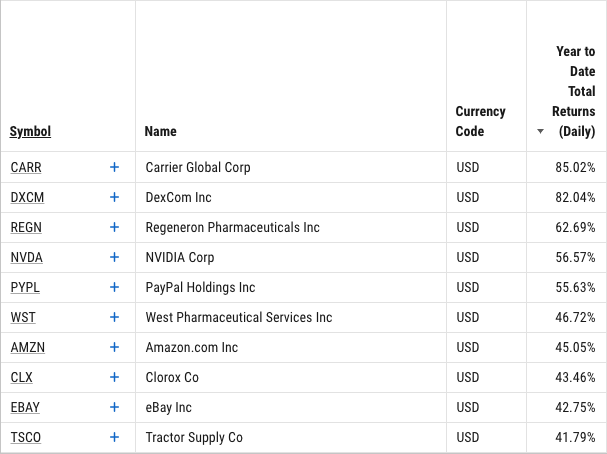| Tuesday's Headlines 1. US markets rally to close out first half of 2020 2. US consumer confidence jumps in June 3. China manufacturing data for June better than expected 4. The equity risk premium for US stocks 5. First half scorecards Markets Closed
 Image courtesy Jan Kruger/Stringer/Getty
Markets Today What a way to end the first half of one of the wildest years in market history. Investors decided to go shopping, and they bought nearly every sector of the U.S. stock market, with all indexes closing in the green. Typically, the last day of the quarter brings heavy volatility with it as portfolio managers rebalance—especially after massive gains. If they rebalanced today, they did so by adding stocks.
Here's how the quarter sums up for U.S. markets:
Granted, all these indexes are coming off a low base, having plunged 35% or more from February to March, but the ascent has been swift and record setting.
Uncertainty will be the overarching theme of the third quarter as the virus is still very much a factor in all of our lives. Regulators and central banks have spent trillions to stem the crisis, but more will be needed, in addition to a healthy dose of common sense. The recovery will be uneven, unpredictable, and unsettling, but we will march on.
As for what happens to markets going forward, nobody really knows. There are plenty of predictions, and we cite a lot of them. We do know what happens historically after huge quarters like the one we just closed. But this year is full of surprises, so don't count on history to be your guide.  chart courtesy LPLFinancial
Headlines:
 chart courtesy Goldman Sachs
The Equity Risk Premium for Stocks In our latest installment of "Why stocks keep going up despite everything..." series, we are looking at the equity risk premium for stocks. The ERP (the pros call it that) refers to the excess return that investing in the stock market provides over a risk-free rate. The 10-year U.S. Treasury yield is the most commonly used security against which equity risk is measured.
Institutional money managers, and some individuals, use the ERP to determine whether investing in stocks fits into their risk profile. Given that the yield on the 10-year U.S. Treasury is between 0.6–0.8%, which is historically low given the Fed's commitment to low interest rates through 2021, the ERP for stocks, as seen through the S&P 500, according to Goldman Sachs, is high but reasonable. For investors seeking yield, meet T.I.N.A. (There is no alternative). The risk in owning stocks is high, but given that rates aren't moving anytime soon, the premium for owning them may be worth it to investors, which could power stocks higher.  chart courtesy YCharts
First Half Scorecards Business journalists like to keep score, so since we are at the halfway mark of the year, we will indulge.
Looking around the world, the countries with the strongest performance continue to be China and the U.S. China has the only positive returns for the year, as seen through the MSCI country indexes. It was the first into and out of the pandemic, and its recovery seems to be proceeding well. Australia and Canada, which are both heavy industrial, energy, and mining-based economies, are seeing a slower recovery given the economic damage in those sectors. Latin America is in bad shape, as COVID-19 ravages Brazil, and the drop in exports and tourism punishes the continent.  Strongest U.S. Stock Sectors I had to look twice at this breakdown, courtesy of YCharts, because I couldn't believe Consumer Discretionary was the best performing sector in the first half of the year. It contains restaurants, hotels, clothing retailers, and other devastated categories in 2020. But it also contains Internet commerce companies like Amazon (AMZN) and eBay (EBAY). Mystery solved.
The Communications sector was the second best performing sector, thank you Alphabet (GOOG) and Facebook (FB). The worst performing sector of the strongest was Industrials. That will rebound if and when economies recover with more fortitude. Energy, obviously, didn't make the top eight. Returns for that index are down 54% this year.  Strongest U.S. Stocks The top three U.S. performing stocks of the S&P 500 were probably not on anyone's top picks list for the year back in January.
 Weakest U.S. Stocks You didn't have to look far outside of the energy, cruise ship, and airline industries to find the worst performing stocks of the year. There's some retailers in there, as well, and Xerox (XRX), which has unfortunately lost its way in the 21st century. I wasn't familiar with TechnipFMC (FTI), but it turns out that it's an energy company with a really confusing name.
SPONSORED BY INVESCO
(chart courtesy YCHARTS)  Shares of Citizens Financial Group are up by over 7% following the bank's announcement that it plans to maintain its current dividend level through the third quarter of 2021. Xilinx's stock price rose by over 6.5% after the integrated circuits manufacturer raised its Q1 quarter revenue guidance.  Shares of Boeing are down by 6% following Norwegian Air canceling an order of nearly 100 jets from the plane manufacturer. Coty's stock price fell by over 5.5% amid Seed Beauty, manufacturer for Kylie Cosmetics, filing a suit against the beauty company for allegedly accepting trade secrets. Word of the Day Rebalancing is the process of realigning the weightings of a portfolio of assets. Rebalancing involves periodically buying or selling assets in a portfolio to maintain an original or desired level of asset allocation or risk. For example, say an original target asset allocation was 50% stocks and 50% bonds. If the stocks performed well during the period, it could have increased the stock weighting of the portfolio to 70%. The investor may then decide to sell some stocks and buy bonds to get the portfolio back to the original target allocation of 50/50.  image courtesy Yale.edu
Today in History June 30, 1932: The total market value of all stocks listed on the New York Stock Exchange scrapes bottom at $15.6 billion, down from $89.7 billion on Sept. 1, 1929.
Sylvester J. Schieber and John B. Shoven, The Real Deal
Want more Investopedia market news?
Sign Up for 'Chart Advisor'
How can we improve the Market Sum? Tell us at marketsum@investopedia.com
CONNECT WITH INVESTOPEDIA
Email sent to: mondemand.forex@blogger.com To update your newsletter preferences or unsubscribe, click here.
114 West 41st St, floor 8 New York NY 10036 © 2020, Investopedia, LLC. All Rights Reserved | Privacy Policy
|
Tuesday, June 30, 2020
Half Time
Subscribe to:
Post Comments (Atom)




No comments:
Post a Comment